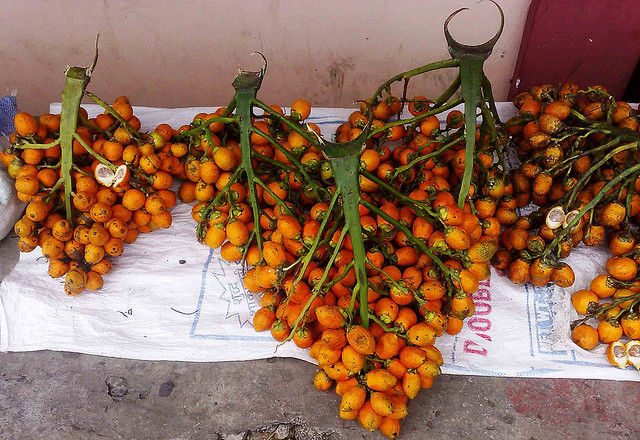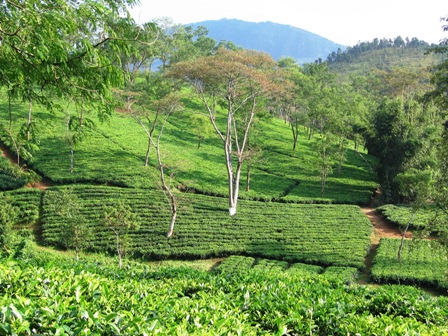 Horticulture Crops
Horticulture Crops
Plantation Crops
 Areca Nut
Areca Nut
Since time immemorial, Arecanut has been grown in Meghalaya as an important commercial crop. In the recent past this crop has been introduced in the northern slopes of Khasi Hills and Ri-Bhoi districts and is found to be doing well. However, this crop is suffering from a disease called ‘Bud Rot’. The disease starts from the top and moves downwards. The control measures against ‘Bud Rot’ are available, but the terrain acts as a serious constraint to spraying operations.
According to the data of the last fifteen years the area, production and productivity has been increasing at an annual average computed rate of 306 Ha, 531 MT and 28.046 kgs/Ha respectively. Comparing this with the data of 1971–72 to 1991–92 wherein the annual average computed rate of increase in the area, production and productivity is 40 Ha, 150 MT and 9.71 kgs/Ha respectively, it can safely be inferred that the effect of ‘Bud Rot’ disease is decreasing and there is a bright prospect for the areca nut growers of the State in future.
Varieties Grown
Local selection, Mangala, Sumangala etc.
 Tea
Tea
The mid regions of Meghalaya were perceived to be agro-climatically suitable for growing tea. In 1974, on the recommendation of the Tea Board officials, Tea Experimental Stations were established at Umsning in Ri-Bhoi District (2.5Ha), Riangdo in West Khasi Hills District (2.0Ha) and Thebronggiri in West Garo Hills District (1.6Ha) in the year 1976–77. The results from all the three stations were encouraging and it was decided to encourage farmers to grow tea as a homestead crop.
In order to supply good planting materials of varieties approved by the Tea Board, the Agriculture Department established a Tea Nursery at Umsning in Ri-Bhoi District and Rongram in West Garo Hills District in 1982-83.
 Apart from the two established tea nurseries at Umsning and Rongram, the Department has started small-scale tea nurseries through the Directorate of Horticulture at Riangdo, Thadlaskein, Umwang and Upper Shillong. The department is also planning to set up tea nurseries in all the seven districts of the State as the farmers have shown keen interest in growing tea as a household crop.
Apart from the two established tea nurseries at Umsning and Rongram, the Department has started small-scale tea nurseries through the Directorate of Horticulture at Riangdo, Thadlaskein, Umwang and Upper Shillong. The department is also planning to set up tea nurseries in all the seven districts of the State as the farmers have shown keen interest in growing tea as a household crop.
The Department have introduced a package incentive scheme which includes (a) Cash Subsidy of Rs 15,000/- per hectare and (b) Supply of plant protection materials like insecticides, weedicides, fungicides, etc. at 50% subsidy.
At present the area under tea is also being expanded to villages around the departmental tea nurseries. These nurseries are manned by tea specialists who also oversee the tea gardens in the farmers’ fields and ensure the flow of good planting material to them through these nurseries. They also assist the farmers in marketing the green tea leaves.
The response of the farmers in the target areas is encouraging and the area under tea is increasing annually. Since the inception of the scheme i.e. 1984-85 to 2000-01, about 508 hectares of land have been brought under tea plantation in the State, thereby producing about 8 (eight) lakh kilograms of green tea leaves during 2000-01 and involving around 530 tea growers.
Cashew Nuts
Cashewnut is extensively grown in West and South Garo Hills. However the bulk of the produce is sold outside the State as raw products. The increase area under this plantation crop is due to the effort for reclamation of jhuming lands.
The cultivation of cashenut is restricted to altitudes below 700m where temperature does not fall below 20°C for long periods. However best production is noticed upto the altitude of 400m. It grows well at reasonably high temperatures and does not tolerate prolonged periods of cold and frost. Does well where at least a minimum of 600 mm of rain is received in a year.
The crop is also sensitive to water logging and hence heavy clay soil are unsuitable, otherwise Cashew grows in almost all soils and when soil PH is in acidic range. More than pH 8.0 is not suitable for commercial cultivation.
Varieties Grown
Ullal-3, Ullal-4, Venguria-1, Venguria-4 and Venguria-7.





